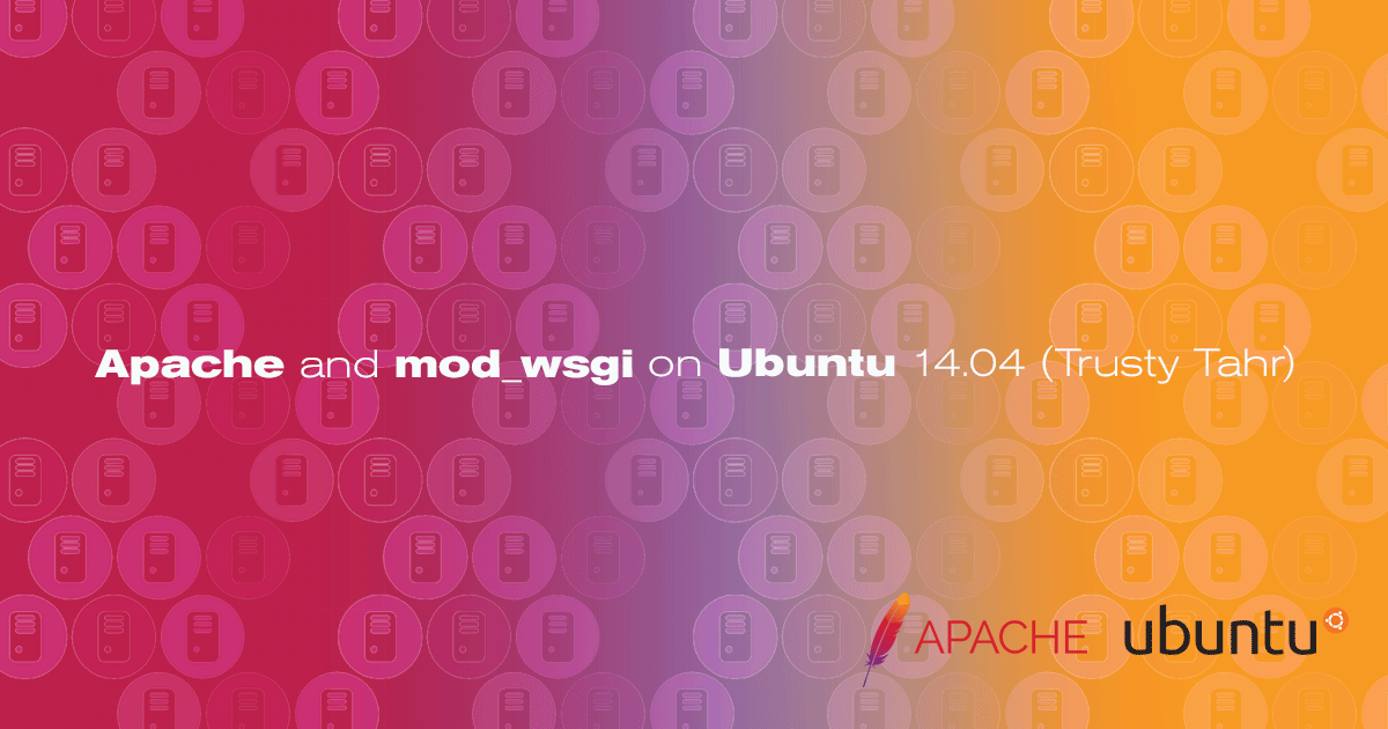Product docs and API reference are now on Akamai TechDocs.
Search product docs.
Search for “” in product docs.
Search API reference.
Search for “” in API reference.
Search Results
results matching
results
No Results
Filters
Apache and mod_wsgi on Ubuntu 14.04 (Trusty Tahr)
- Deprecated guides:
- Ubuntu 12.04
- Ubuntu 10.10
- Ubuntu 10.04
- Fedora 14
- Debian 6
- Debian 5
Traducciones al EspañolEstamos traduciendo nuestros guías y tutoriales al Español. Es posible que usted esté viendo una traducción generada automáticamente. Estamos trabajando con traductores profesionales para verificar las traducciones de nuestro sitio web. Este proyecto es un trabajo en curso.
DeprecatedThis guide has been deprecated and is no longer being maintained.



mod_wsgi provides a method for simply deploying WSGI applications with Apache. WSGI is used to deploy applications written with frameworks and tools like Django, Web.py, Werkzug, Chery.py, TurboGears, and Flask. This guides outline this installation and configuration process for WSGI with Apache on Ubuntu 14.04.Before You Begin
Ensure that you have followed the Getting Started and Securing Your Server guides, and the Linode’s hostname is set.
We recommend that you are already familiar with Apache before beginning this guide.
Update your system:
sudo apt-get update sudo apt-get upgrade
sudo prefix. For more information on privileges see our Users and Groups guide.Install Dependencies
Issue the following commands to ensure that your system’s package repositories and installed programs are up to date and that all required software is installed:
apt-get install apache2 python-setuptools libapache2-mod-wsgi
Your application may require additional dependencies. Install these either using the Ubuntu package tools or by using the easy_install command included in python-setuptools before proceeding.
Configure WSGI Handler
In order for mod_wsgi to be able to provide access to your application, you will need to create a application.wsgi file inside of your application directory. The application directory should be located outside of your DocumentRoot. The following three sections each present a different application.wsgi example file to illustrate the basic structure of this file:
Basic Hello World WSGI Configuration
In this example, the application is stored in /var/www/html/example.com/application directory. Modify this example and all following examples to conform to the actual files and locations used in your deployment.
- File: /var/www/html/example.com/application/application.wsgi
1 2 3 4 5 6 7 8 9 10 11 12 13 14 15 16import os import sys sys.path.append('/var/www/html/example.com/application') os.environ['PYTHON_EGG_CACHE'] = '/var/www/html/example.com/.python-egg' def application(environ, start_response): status = '200 OK' output = 'Hello World!' response_headers = [('Content-type', 'text/plain'), ('Content-Length', str(len(output)))] start_response(status, response_headers) return [output]
You must append the path of your application to the system path as above. The declaration of the PYTHON_EGG_CACHE variable is optional but may be required for some applications when WSGI scripts are executed with the permissions of the web server. The WSGI application must be callable as application, regardless of how the application code is structured.
Web.py WSGI Configuration
In this example the Web.py application is embedded in a application.wsgi file. The Web.py Framework must be installed in order for the following application to run successfully.
- File: /var/www/html/example.com/application/application.wsgi
1 2 3 4 5 6 7 8 9 10 11 12 13 14 15 16 17import web urls = ( '/(.*)', 'hello' ) class hello: def GET(self, name): if not name: name = 'World' return 'Hello, ' + name + '!' if __name__ == "__main__": app.run() app = web.application(urls, globals(), autoreload=False) application = app.wsgifunc()
Django WSGI Configuration
The following example application.wsgi file is configured for Django applications:
- File: /var/www/html/example.com/application/application.wsgi
1 2 3 4 5 6 7 8 9 10 11import os import sys sys.path.append('/var/www/html/example.com/application') os.environ['PYTHON_EGG_CACHE'] = '/var/www/html/example.com/.python-egg' os.environ['DJANGO_SETTINGS_MODULE'] = 'settings' import django.core.handlers.wsgi application = django.core.handlers.wsgi.WSGIHandler()
Django must be installed on your system along with a working Django application before this example will function. The DJANGO_SETTINGS_MODULE points to the “settings.py file for your application, which would be located at /var/www/html/example.com/application/settings.py in the case of this example.
Configure Apache
Deploy the following VirtualHost configuration and modify the paths and domains to reflect the requirements of your application:
- File: Apache `VirtualHost` Configuration
1 2 3 4 5 6 7 8 9 10 11 12 13 14 15 16 17<VirtualHost *:80> ServerName example.com ServerAlias www.example.com ServerAdmin username@example.com DocumentRoot /var/www/html/example.com/public_html ErrorLog /var/www/html/example.com/logs/error.log CustomLog /var/www/html/example.com/logs/access.log combined WSGIScriptAlias / /var/www/html/example.com/application/application.wsgi Alias /robots.txt /var/www/html/example.com/public_html/robots.txt Alias /favicon.ico /var/www/html/example.com/public_html/favicon.ico Alias /images /var/www/html/example.com/public_html/images Alias /static /var/www/html/example.com/public_html/static </VirtualHost>
In this example, the WSGIScriptAlias directive tells Apache that for this VirtualHost, all requests below / should be handled by the WSGI script specified. The series of four Alias directives allow Apache to serve the robots.txt and favicon.ico files as well as all resources beneath the /images and /static locations, directly from the DocumentRoot without engaging the WSGI application. You can add as many Alias directives as you require.
When you have configured your Apache VirtualHost, issue the following command to restart the web server:
service apache2 restart
You will need to restart the web server every time the application.wsgi file changes. However, all other modifications to your application do not require a web server restart. Congratulations! You have now successfully deployed a WSGI application using mod_wsgi.
More Information
You may wish to consult the following resources for additional information on this topic. While these are provided in the hope that they will be useful, please note that we cannot vouch for the accuracy or timeliness of externally hosted materials.
This page was originally published on
